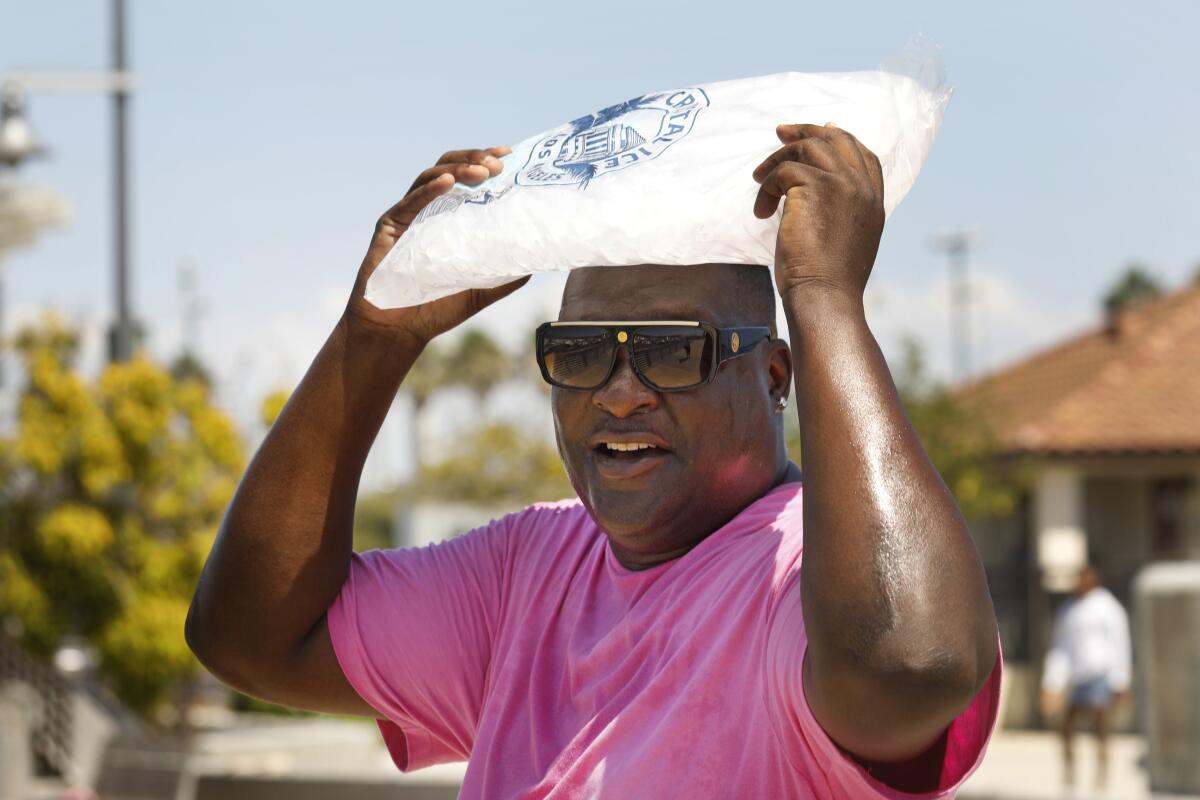Officials plead with Californians to reduce energy use or face blackouts

With California moving into the worst phase of a historic heat wave, authorities Monday amplified their urgent call for residents to reduce energy use voluntarily or face the prospect of rolling blackouts.
“We need two to three times as much conservation as we’ve been experiencing to keep the power on with these historically high temperatures and demand,” warned Elliot Mainzer, chief executive of the California Independent System Operator, which runs the state’s power grid, at a morning news conference.
The already-scorching temperatures are forecast to climb as high as 115 degrees Monday in many parts of the state, including inland areas of Los Angeles. Records in Fresno, Merced and other parts of the Central Valley are expected to be broken Monday afternoon, only to be topped Tuesday, according to the National Weather Service.
In response to a Flex Alert first issued Wednesday, Californians have lowered their energy use by about 2%. But Mainzer said two to three times as much is necessary, given the forecast.
“Blackouts, rotating outages are a possibility today, and some of the efforts of consumers to really lean in and take these actions after 4 p.m. today are absolutely essential,” he said.
Key to avoiding blackouts Monday and Tuesday, officials said, is reducing energy use in the hours of greatest consumption: late afternoon and evening. In response to what officials said was an unprecedented demand for power, the Flex Alert was extended for an extra hour Monday and Tuesday to cover the period from 4 to 10 p.m.
“This is not about being hot all day,” said Alice Reynolds, president of the California Public Utilities Commission. She encouraged Californians to “precool” their homes by cranking air conditioning low in the morning, then raising thermostats to 78 degrees in the late afternoon.
In addition to monitoring thermostats, residents are asked to avoid using appliances and to turn off unnecessary lights. Southern California Edison advised charging phones, laptops and electric vehicles before 4 p.m., according to an email to customers.
“We are in an extraordinary event,” said California Energy Commissioner Siva Gunda. He said Tuesday’s anticipated demand from the grid — 51,000 megawatts — “would be the highest in September that we’ve ever seen.”
To bolster its own power supply, California is importing energy from utility companies in the Pacific Northwest, which has been spared the heat.
The extreme heat in California will begin ebbing Wednesday but is expected to remain dangerous until the weekend.
“We’re going to continue to see a long-duration heat wave across the state through this week, and that’s going to bring widespread heat impacts or what you’ll commonly hear is high to very high heat risk,” said National Weather Service meteorologist Sarah Rogowski.
Public health officials said families and organizations should consider rescheduling or canceling outdoor activities.
“It’s not over; we have a few more days. It’s going to be tough,” said Dr. Tomas Aragon, the state public health officer.
The heat and bone-dry conditions pose a challenge for fire crews. The California Department of Forestry and Fire Protection had more than 4,000 firefighters working on 14 large fires throughout the state.
Just before noon, a blaze sprang up in a rural area east of the San Diego County town of Ramona. It quickly spread to 50 acres in the Witch Creek community, prompting the evacuation of people and livestock from a corridor along Highway 78.
About 150 firefighters effectively put down the blaze. But a wind-driven ember ignited another fire outside the perimeter, and by midafternoon, helicopters were dropping water on the spot in an attempt to quell the flames.
In L.A., residents flocked to shopping malls, cooling centers and the coast, where temperatures hovered in the 90s.
At the Mid Valley Senior Center in Panorama City, about a dozen elderly women sat Monday morning chatting, drinking coffee and playing Lotería in the air conditioning of the gym. A large fan added to the relief.
“Good morning!” newcomers called out in Spanish as they strolled in with bags of snacks and water. Staff said Saturday and Sunday each saw roughly 10 people using the center, the majority elderly and members of the homeless community.
Carmen Bean, a home healthcare worker, took refuge within the cool walls of the South Los Angeles Sports Activity Center with her chihuahua, Button. The fans the pair had at home weren’t enough to fight the heat, and for the last couple of days, they had sat on the porch until 3 a.m.
“I just asked for help from the good Lord above,” Bean said. The dog is extremely sensitive to temperature, she said, making her worry while she is away at work.
“So I put the fan directly on her, put a lot of ice in her bowl, and I pray she’s OK when I get back,” Bean said.
Across town, a more famous L.A. animal found his own way of dealing. Just before 10 p.m. Sunday, the mountain lion known as P-22 was spotted in a Los Feliz neighborhood drinking from a leaking yard sprinkler.
“I noticed this massive creature lying down on the sidewalk almost in a sphinx pose, lapping up water,” said Victoria Calleja, who was walking her chihuahua, Hermione, on Griffith Park Boulevard.
She and the puma locked eyes, she said, but he returned to drinking, “completely unfazed by us.”
“It is sort of crazy to be running into a mountain lion just up the street from Trader Joe’s,” Calleja said.
Told of P-22’s sidewalk imbibing, Beth Pratt, a regional executive director for the National Wildlife Federation, laughed. P-22 had taken sips from a bird bath before, but targeting faulty irrigation was new.
“I’ve got to applaud him,” she said. “He’s beating the heat.”
More to Read
Sign up for Essential California
The most important California stories and recommendations in your inbox every morning.
You may occasionally receive promotional content from the Los Angeles Times.












